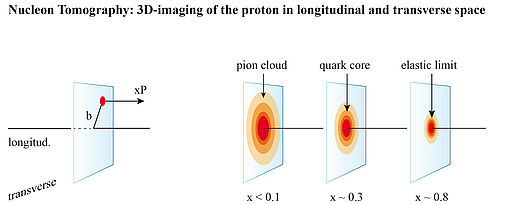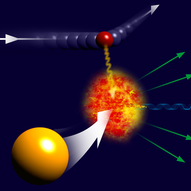
Theory of Hard Exclusive Reactions
![]()
A remarkable development of experimental techniques in the last decades allows one to study "exclusive" or "semi-inclusive" hard reactions where in addition to the momenta of colliding particles one measures the structure and particle content of the final hadronic state. Such reactions are interesting in many respects. One motivation is to get access to the three-dimensional picture of the nucleon in the longitudinal and transverse momentum plane. Another motivation is to get control over the strong interaction effects in weak decays of heavy hadrons in order to reveal possible "new physics" phenomena beyond the Standard Model.

This is altogether a very large field of research. In Regensburg we work in several directions:
- Establishment of a high precision framework for the analysis of DVCS, including three-loop evolution equations and full account of "kinematic" power corrections.
- Light Cone Sum Rule calculations of elastic and transition form factors. This is a powerful approach to calculate the form factors in the situation that a perturbative treatment fails. It is based on QCD factorization aided by dispersion relations and duality.
- TMD factorization and related topics. This is a relatively new version of the QCD factorization strategy, where in difference to conventional "collinear" factorization the parton transverse momentum dependence is taken into account in "hard" functions. In recent years some basic issues about the status and applicability of this technique have been clarified, but many issues still remain open and are subject to intensive research.
Some of our recent publications can be found here
High Energy Physics
Heidi Decock: -2006
Monika Maschek: -2008

